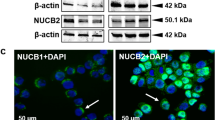Abstract
NERVE GROWTH FACTOR (NGF) is essential for the development of sympathetic nerve cells1. The richest known source of NGF is the submaxillary gland of the adult male mouse2, and NGF from this source has been completely purified and thoroughly characterised3. The active entity (β-subunit) is a protein comprising a dimer of identical 118-residue chains4,5. Another form of mouse NGF, the 2.5S form, has been isolated6 and shown to differ from the β entity in that some of the monomeric chains have undergone enzymatic cleavage of the amino-terminal octapeptide and carboxy-terminal arginine residues3,4,7–9. The 2.5S dimer therefore contains both 118-residue chains and shortened chains. The salivary gland of the mouse seems to be unique in that the corresponding glands of the rat, guinea pig, cow, pig, rabbit and man contain no NGF10,11. No other clearly characterised source of NGF in mammalian tissue in vivo has been reported. We now report a new, rich source of NGF–the prostate glands of the adult male guinea pig.
This is a preview of subscription content, access via your institution
Access options
Subscribe to this journal
Receive 51 print issues and online access
$199.00 per year
only $3.90 per issue
Buy this article
- Purchase on Springer Link
- Instant access to full article PDF
Prices may be subject to local taxes which are calculated during checkout
Similar content being viewed by others
References
Levi-Montalcini, R. & Angeletti, P. U. Physiol. Rev. 48, 534–569 (1968).
Cohen, S. Proc. natn. Acad. Sci. U.S.A. 46, 302–311 (1960).
Server, A. C. & Shooter, E. M. Adv. Protein Chem. 31, 339–409 (1977).
Angeletti, R. H. & Bradshaw, R. A. Proc. natn. Acad. Sci. U.S.A. 68, 2417–2420 (1971).
Greene, L. A., Varon, S., Piltch, A. & Shooter, E. M. Neurobiology 1, 37–48 (1971).
Bocchini, V. & Angeletti, P. U. Proc. natn. Acad. Sci. U.S.A. 64, 787–794 (1969).
Moore, J. B., Mobley, W. C. & Shooter, E. M. Biochemistry 13, 833–840 (1974).
Mobley, W. C., Schenker, A. & Shooter, E. M. Biochemistry 15, 5543–5552 (1976).
Angeletti, R. H., Bradshaw, R. A. & Marshall, G. R. Int. J. Peptide Protein Res. 6, 321–328 (1974).
Banks, B. E. C. et al. Nature 246, 503–504 (1973).
Harper, G. P., Pearce, F. L. & Vernon, C. A. (in preparation).
Varon, S., Nomura, J., Perez-Polo, J. R. & Shooter, E. M. Meth. Neurochem. 3, 203–229 (1972).
Fenton, E. L. Expl Cell. Res. 59, 383–392 (1970).
Pearce, F. L., Banthorpe, D. V., Cook, J. M. & Vernon, C. A. Eur. J. Biochem 32, 569–575 (1973).
Bamburg, J. R., Derby, M. A. & Shooter, E. M. Neurobiology 1, 115–120 (1971).
Stoeckel, K., Gagnon, C., Guroff, G. & Thoenen, H. J. Neurochem. 26, 1207–1211 (1976).
Bailey, G. S. et al. Biochim. biophys. Acta 437, 259–263 (1976).
Suda, K., Barde, Y. A. & Thoenen, H. Proc. natn. Acad. Sci. U.S.A. 75, 4042–4046 (1978).
Caramia, F., Angeletti, P. U. & Levi-Montalcini, R. Endocrinology 70, 915–922 (1962).
Bueker, E. D., Weis, P. & Schenkein, I. Proc. Soc. exp. Biol. Med. 118, 204–207 (1965).
Goldstein, M. N. & Burdman, J. A. Anat. Rec. 151, 199–208 (1965).
de Champlain, J., Malmfors, T., Olson, L. & Sachs, C. Acta physiol. scand. 80, 276–288 (1970).
Owman, C., Sjöberg, N. O. & Swedin, G. Z. Zellforsch. 116, 319–341 (1971).
Kato, D. Yonaga acta medica 16, 172–175 (1973).
Levi-Montalcini, R. Harvey Lect. 60, 217–259 (1966).
Cohen, S. Natn. Cancer Inst. Monogr. 13, 13–37 (1964).
Cohen, S. Devl Biol. 12, 394–407 (1965).
Cohen, S. & Taylor, J. M. Macromolecules Regulating Growth and Development, 25–42 (Academic, New York, 1974).
Laemmli, U. K. Nature 227, 680–685 (1970).
Studier, F. W. J. molec. Biol. 79, 237–248 (1973).
Author information
Authors and Affiliations
Rights and permissions
About this article
Cite this article
HARPER, G., BARDE, Y., BURNSTOCK, G. et al. Guinea pig prostate is a rich source of nerve growth factor. Nature 279, 160–162 (1979). https://doi.org/10.1038/279160a0
Received:
Accepted:
Published:
Issue Date:
DOI: https://doi.org/10.1038/279160a0
This article is cited by
-
Implantable microdevice for peripheral nerve regeneration: materials and fabrications
Journal of Materials Science (2011)
-
Effects of castration on the expression of brain-derived neurotrophic factor (BDNF) in the vas deferens and male accessory genital glands of the rat
Cell and Tissue Research (2006)
-
Nerve growth factor stimulates in vitro invasive capacity of DU145 human prostatic cancer cells
Journal of Cancer Research and Clinical Oncology (1997)
-
Nerve growth factor antibodies recognize neurotrophin-3
Neurochemical Research (1993)
-
The NGF complex from the African ratMastomys natalensis
Neurochemical Research (1991)
Comments
By submitting a comment you agree to abide by our Terms and Community Guidelines. If you find something abusive or that does not comply with our terms or guidelines please flag it as inappropriate.



